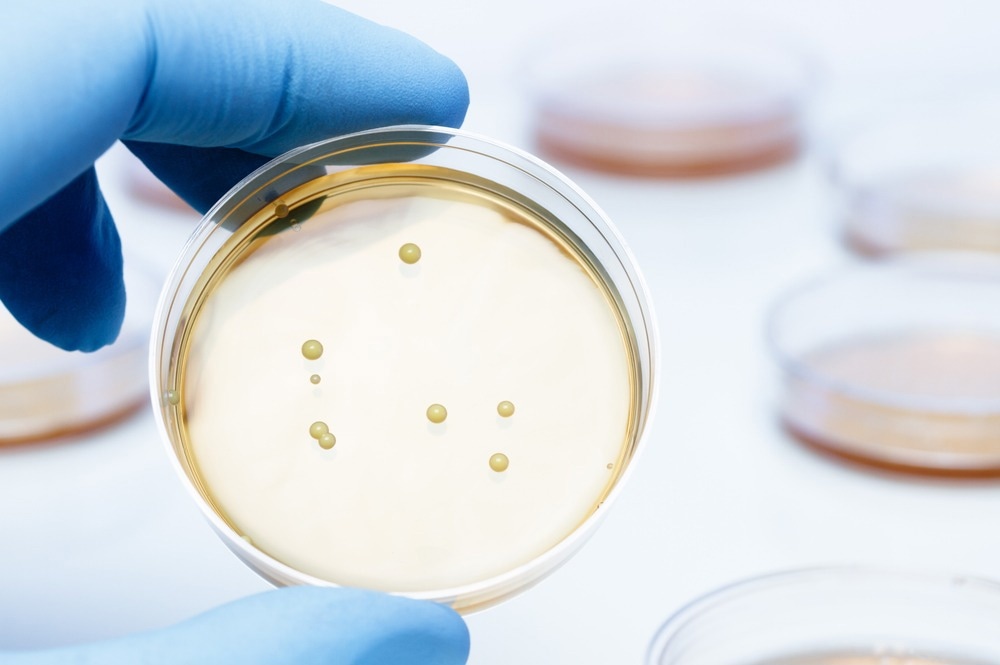All microorganisms do not cause harmful diseases. Several microbes synthesize biologically active molecules that contain medicinal value. The utilization of microorganisms for medicinal purposes is known as microbial therapeutics. Scientists have developed different types of microbial therapeutics, such as live bacterial prophylactic vaccines, probiotics, and fecal microbiota transplant (FMT), to improve human health and provide protection and cure for diseases.

Image Credit: Oscar Sweep/Shutterstock.com
Importance of Microbial Therapeutics over Conventional Treatments
Microbial therapeutics are applied to remove tumors, prevent infections, and for the treatment of metabolic disorders. Some key advantages of microbial therapeutics over the conventional system of medicine are low production cost, minimal side effects, and decreased dosage requirements. After realizing the effectiveness of some microbes, many pharmaceutical companies have invested in this form of therapeutics.
Studies have highlighted some of the adverse effects associated with the conventional system of medicine. For instance, conventional therapies cause resistance to chemotherapy and antibiotics and exhibit poor specificity. Microbial therapeutics overcome these limitations and improve health conditions with minimal side effects.
Apart from naturally residing microbes with therapeutic capacity, the introduction of genetically engineered microbes also exhibited improved therapeutic efficacy without side effects. Several studies have shown that gut microbes play an important role in maintaining human health. Dysbiosis or microbial imbalance could cause disease onset.
Microbes with Therapeutic Properties
Microorganisms are also engineered to perform specific functions in the human body. This strategy is known as live therapeutics. Many microbes interact with hosts and prevent the onset of the disease; for example, Christensenella sp. effectively decreases depression and anxiety-like behavior. Metabolic disorders can be rectified via Akkermansia muciniphila, which protects an individual from atherosclerosis by lowering gut permeability and preventing inflammation.
Bifidobacterium longum reduces the severity of Crohn's disease. It can also repair the integrity of the damaged mucus layer due to a high-fat diet. Interestingly, scientists observed that Lactobacillus johnsonii protects against cancer.
Maintaining the balance of butyrate-producing bacteria substantially improves insulin production. This was achieved by transferring fecal microbes from lean to obese mice. Scientists reported that antibiotic-resistant pathogens, which repeatedly cause urinary tract infections, were significantly reduced after FMT. Clinical trials that evaluated the efficacy of FMT revealed that this treatment could considerably improve liver disorders, alcoholic hepatitis, the progression of fibrosis, and hepatic encephalopathy.
Psychobiotics are a group of agents (e.g., prebiotic, postbiotic, probiotic, etc.) that target the gut-brain axis and confer mental health. For instance, psychobiotics alleviate psychotropic effects, including stress, anxiety, and depression. Studies have shown that brain and gut microbes interact through immunoregulatory pathways, vagus nerves, and the neuroendocrine system.

Image Credit: NatalieIme/Shutterstock.com
Methods of Implementation of Microbial Therapeutics
Several strategies have been developed to establish the host-microbiome interaction that improves the microbial therapeutic effect. Some of the common microbial therapeutic methods are additive therapy, subtractive therapy, and modulatory therapy.
As the name suggests, addition therapy is associated with the addition of beneficial microbial consortia or strain, while subtractive therapy deals with the removal of harmful pathogens that causes disease. Modulatory therapy is linked with modifying host-microbiome interaction by an external non-living agent to alter certain functions.
FMT is a relatively new technique that replaces pathogenic microbes with beneficial microbes. This technique involves the incorporation of healthy microbes from healthy donors to recipients via varied methods. To reduce transmission of infection, donors must be thoroughly screened following strict guidelines. Studies have shown that the fecal filtrate of a healthy donor, containing metabolites, bacterial debris, DNA, etc., can effectively cure recurrent Clostridioides difficile infection (CDI).
Probiotic therapy is a form of additive therapy that employs natural or genetically engineered therapeutic microbes to improve an individual's health. Some common microorganisms used as probiotics are Bifidobacteria, Lactobacilli, and E.coli. The main working principle of probiotics is the competitive exclusion of pathogens by producing bacteriocins and competing for nutrition and attachment sites. Probiotics substantially increase the immune-stimulatory and nutritional status of the host by improving gut-microbiome composition.
Antibiotic treatment is a subtractive therapy that uses bacteriocins and bacteriophages to target and eliminates harmful pathogens. This treatment exhibits minimal side effects on other microbes. Bacteriocins affect the pathogen via different mechanisms, including overall cell lysis, toxins, membrane rupture, etc. This method is effective against several pathogens, such as Bacillus cereus, Pediococcus, Clostridium, Geobacillus stearothermophilus, and Enterococcus.
Modulatory therapy manipulates the gut microbiome to improve human health. Restoration of gut microbiota is possible through simple changes in diet and exercise. Athletes, such as marathon runners, were examined, and a high concentration of Veillonella was found, which aided the individual's exercise endurance.
Challenges Related to Microbial Therapeutics
One of microbial therapeutics' primary challenges is identifying microbes that are appropriately effective against disease complexities. There are various parameters associated with the optimal selection of microbes for therapeutics. The survival of a microbe within the body is a key factor. For example, Bacteroides sp. can successfully colonize within the colon and caecum; however, Lactobacillus lactis cannot colonize in the intestine.
Most microbial therapeutic research has been carried out using rodent models; therefore, the efficacy of these therapeutic approaches must be determined using human clinical trials. There is a need for regulatory guidelines to address the issues related to the biosafety of microbial therapeutics. This will help reduce the adverse effects related to engineered microbes.
Future Perspectives
Scientists predict that globally microbial therapeutics will grow by 2027 and acquire a market size worth USD 1,731 million. More studies are required to understand the microbe-host interactions to develop a more efficient treatment. Effective strategies, e.g., quick genomic characterization, must be developed to eliminate microbial contamination. Pharmaceutical companies must develop bacteria-specific products to avoid the elimination of good microbes from the body.
Sources:
- Yadav, M., and Chauhan, N.S, (2022) Microbiome therapeutics: exploring the present scenario and challenges, Gastroenterology Report, 10. https://doi.org/10.1093/gastro/goab046
- Youxian, L .and Kenya, H. (2021) Toward the development of defined microbial therapeutics, International Immunology, 33(12), pp. 761–766. https://doi.org/10.1093/intimm/dxab038
- Alagiakrishnan,K. andHalverson, T. (2021) Microbial Therapeutics in Neurocognitive and Psychiatric Disorders. Journal of Clinical Medicine Research, 13(9), pp. 439-459.
- Ainsworth, C. (2020) Therapeutic microbes to tackle disease. Nature, 577, pp. S20-S22. doi: https://doi.org/10.1038/d41586-020-00201-6
- Jimenez, M. et al. (2019) Microbial therapeutics: New opportunities for drug delivery, Journal of Experimental Medicine, 216 (5), pp. 1005–1009.https://doi.org/10.1084/jem.20190609
Further Reading
Last Updated: Nov 25, 2022